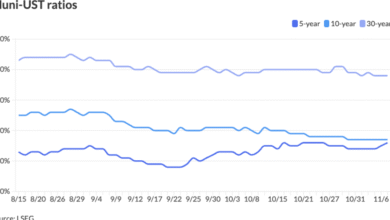How the Largest Bond Funds Did in Q3 2025

Key Takeaways
- Most of the largest active bond funds beat their peers in the quarter, while most of the largest index funds lagged.
- The PIMCO Total Return Fund tied for the top rank among the largest active funds.
- The Vanguard Intermediate-Term Corporate Bond Fund ranked highest among the largest index funds.
After the Federal Reserve’s first interest rate cut of the year, the third quarter of 2025 ended with the majority of the 10 largest actively managed bond funds beating their category peers, while most of the largest bond index funds lagged.
The $45 billion PIMCO Total Return Fund PTTRX ranked the highest in its category out of the largest active US bond funds. Its 2.7% return for the quarter placed it in the 3rd percentile of the intermediate core-plus bond category. The $99 billion Dodge & Cox Income Fund DOXIX was just behind, with a 2.5% return placing it in the 6th percentile of the same category. The active fund that ranked the worst relative to its peers was the $97 billion American Funds Bond Fund of America RBFGX, where its 2% return put it in the 72nd percentile of the intermediate core category.
The picture for the largest US bond index funds was less rosy, with only two outperforming their categories. The highest-ranking fund was the $59 billion Vanguard Intermediate-Term Corp Bond ETF VCIT, which returned 3.1%, putting it in the 35th percentile of the corporate bond category. “Funds that have been overweight in corporate bonds relative to their benchmarks have performed well in the last few months,” says Dominic Pappalardo, chief multi-asset strategist at Morningstar.
Each quarter, we review the short- and long-term performance of the largest active bond funds and index-tracking funds. Many of these funds, such as the Vanguard Total Bond Market Index Fund, are core holdings in portfolios, especially retirement accounts. This list of funds includes both traditional mutual funds and exchange-traded funds. The list includes the funds that were the largest as of the beginning of the second quarter.
When evaluating funds, investors should focus on long-term returns across multiple years and market cycles. However, short-term returns can provide valuable information about biases within strategies.
Performance data for this article was based on the lowest-cost share class for each fund. Some funds may be listed with share classes not accessible to individual investors outside retirement plans. The individual investor versions of those funds may carry higher fees, reducing returns to shareholders. For longer-term returns, if a share class was launched more recently than the period mentioned, an older share class was substituted if one exists.
The Largest Active Bond Funds: The Best Q3 Performers
The largest active US bond funds had a stellar third quarter after mixed performance in the second. Seven of the 10 outperformed their category peers, with two in the top decile.
The highest-ranking fund was the PIMCO Total Return fund. Its 2.7% return put it in the 3rd percentile of the intermediate core-plus category, compared with the 2.1% return for the Morningstar US Core Plus Bond Index and the average 2.1% return for the category. That performance comes after its manager, Mohit Mittal, made changes to the fund’s approach. “The firm tasked Mittal with improving things by incorporating high-conviction ideas from across the firm to a greater degree than his predecessor,” writes Morningstar principal Brian Moriarty. “The goal has been to improve results without introducing an unwelcome level of volatility, in part via rigorous position sizing.” The Gold-rated fund’s Process rating was upgraded to High from Above Average in January.
Pimco Total Return’s third-quarter returns were closely followed by the Dodge & Cox Income Fund, which returned 2.5%, landing it in the 6th percentile of the intermediate-core plus category. “The managers know what they’re good at and stick to it,” writes Morningstar senior principal Mara Dobrescu of the Gold-rated fund. “They invest with a three-to-five-year horizon and view income as an important driver of long-term returns, so they aim to assemble a portfolio that delivers more yield than the index.”
The best-performing name among the 10 largest active bonds funds in terms of absolute returns was the Gold-rated, $79 billion Vanguard Intermediate-Term Tax-Exempt Bond Fund VWIUX. The fund returned 2.8%, putting it in the 29th percentile of the municipal national intermediate category. Funds in the category averaged a 2.6% return for the quarter, while the Bloomberg Municipal Bond 1-15 Year Index returned 2.6%. “[The fund’s] experienced leaders employ a disciplined approach to create a diversified portfolio while its ultralow fee consistently gives them an edge over peers,” writes Morningstar associate analyst Ken Noguchi.
The Largest Active Bond Funds: The Worst Q3 Performers
The lowest-ranking active bond fund was the American Funds Bond Fund of America, which returned 2%, landing it in the 72nd percentile of the intermediate core bond category and just behind of its category average and Morningstar benchmark.
The lowest in terms of absolute return was the Bronze-rated $53 billion Vanguard Short-Term Investment Grade Bond Fund VFSIX, which returned 1.7%, placing it in the 16th percentile of the short-term bond category. Funds in that category averaged a 1.4% return, and the Morningstar US 1-3 year Government & Corporate Bond Index gained 1.2% in the quarter. The Bronze-rated fund’s disciplined approach ”creates a repeatable process, yet its focus on corporate bonds makes it a less diversified option in the short-term bond category,” Noguchi writes.
The Largest Bond Index Funds: The Best Q3 Performers
During the quarter, all but two of the largest index funds lagged their categories. The two exceptions were the $59 billion Vanguard Intermediate-Term Corporate Bond Index Fund VCIT and the iShares Core US Aggregate Bond ETF AGG. The Vanguard fund returned 3.1%, placing it in the 35th percentile of the corporate bond category. Funds in the category averaged a 3.0% return for the quarter, while the Morningstar US Corporate Bond Index averaged 3.1%.
The Vanguard fund was also the best of the largest index funds in terms of absolute returns. The fund “offers an inexpensive and well-constructed portfolio of investment-grade corporate bonds set to mature in five to 10 years,” writes Morningstar analyst Lan Anh Tran of the Gold-Rated fund.
The iShares fund returned 2%, putting it in the 47th percentile of the intermediate core bond category.
The Largest Bond Index Funds: The Worst Q3 Performers
The $58 billion iShares 0-3 Month Treasury Bond ETF SGOV ranked lowest in its category out of the largest US bond index funds. Its 1.1% gain put it in the 86th percentile of the ultrashort bond category. Funds in that category averaged a 1.3% return, while the Bloomberg Government/Corporation 1-Year Duration Index gained 1.1%.
The worst performers in terms of absolute performance were the $128 billion Vanguard Total International Bond Index Fund II VTILX and the $108 billion Vanguard Total International Bond Index Fund VTIFX. Both funds returned 0.7% for the quarter, landing them in the 83rd and 79th percentile, respectively, compared with 1.3% for the global-bond USD hedged category and the 1.1% for the Morningstar Global Bond USD-Hedged Index. “Vanguard Total International Bond Fund packages a broad swath of investment-grade international bonds into a diversified and low-cost portfolio,” says Tran of the Silver-rated fund. “It trades some upside potential for a higher-quality portfolio that limits transaction costs and smooths returns.”
The Long-Term Performance of the Largest Active Bond Funds
All 10 of the largest active bond funds beat their category averages over the past three years. The lowest-ranked one in its category, the Strategic Advisors Fidelity Income Fund, still returned 5.7% annually, putting it in the 49th percentile of the intermediate core-plus category.
The highest-ranking fund was the Dodge & Cox Income Fund, which returned an average of 6.7% a year, which placed it in the 10th percentile of the intermediate core-plus category. The fund with the highest absolute returns over the past three years was the $198 billion PIMCO Income Fund PIMIX, which returned 8.5% a year, putting it in the 23rd percentile of the multisector bond fund category.
Morningstar senior principal Eric Jacobson describes the Gold-Rated PIMCO Income Fund as drawing on “an army of managers and analysts in groups covering virtually every corner of the bond market, as well as the guidance of Pimco’s investment committee and input from macroeconomic specialists.”
The Long-Term Performance of the Largest Bond Index Funds
Over the past three years, two of the largest bond index funds beat their categories. The $61 billion Vanguard Short-Term Inflation Protected Securities ETF VTIP returned 5.4% a year, putting it in the 28th percentile of the short-term inflation-protected bond category. The Vanguard Intermediate-Term Corporate Bond ETF gained 8.0% a year, putting it in the 9th percentile of the corporate bond category over that period. Tran describes the Gold-rated TIPS fund as providing “great inflation protection at a low cost,” while the also Gold-rated corporate bond fund has a “well-constructed portfolio of intermediate-term corporate bonds.”
All eight of the other largest index funds underperformed their categories over that time. The worst-performing fund relative to its category was the Vanguard Short-Term Bond ETF BSV, which gained 4.9% annually over the past three years, putting it in the 84th percentile of the short-term bond category.
Credit: Source link






